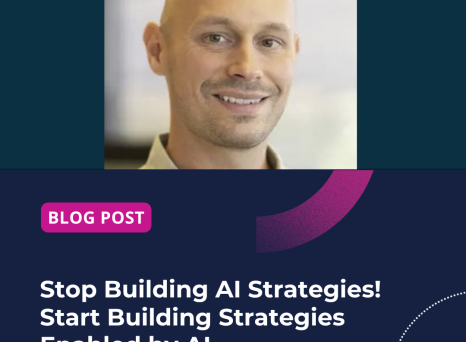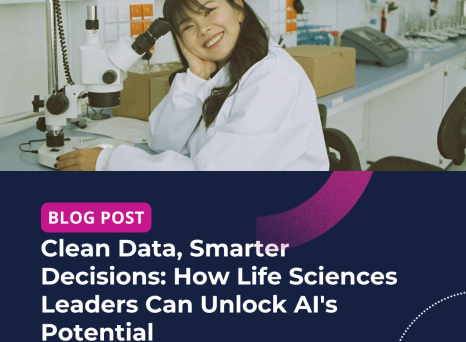According to a McKinsey study, 65% of organizations are already using artificial intelligence (AI) regularly. And it’s on the horizon for those that aren’t — a Logicalis report found that 9 out of 10 Chief Information Officers (CIOs) plan to introduce AI into their organizations in 2024. Staying ahead of the latest technological advancements is central to the CIO’s role. At the same time, there is growing pressure on CIOs to increase organizational efficiency and protect profitability. So, when they’re evaluating new technology, return on investment (ROI) is under the microscope.
CIOs must consider where AI can add strategic value to their business and project goals. But, with so many AI applications, how do you identify the most effective for your organization? There’s one safe bet for the majority of CIOs: AI-enhanced predictive analytics.
In this article, we’ll explore the power of AI predictive analytics as a highly valuable use case for CIOs and an integral feature of AI-enabled project portfolio management (PPM) technology. We’ll showcase how CIOs can harness this AI use case to boost ROI, identify cost-saving opportunities, and optimize the strategic value of projects and portfolios.
Predictive Analytics and AI
Predictive analytics uses historical data to forecast outcomes based on similar drivers or parameters. When you apply it to business decision-making, its insights can help you:
- Cut costs
- Reduce unnecessary waste
- Boost efficiency
- Improve project success rates
Businesses have been using predictive models for years to forecast finances, analyze risks, plan resources, and more. AI supercharges predictive analytics by applying deep learning and machine learning (ML) algorithms to predictive models. This enhances them in several ways, including:
- Greater data accuracy and continuous improvement
- Faster analysis of large volumes of data and complex datasets
- The ability to identify patterns and balance multiple variables
4 Ways AI-Powered Predictive Analytics Benefits The CIO
So, why does this matter to the CIO? There are two main reasons.
Firstly, the pressure to implement AI and deliver strong ROI is growing. With AI predictive analytics, you can distribute data-backed decision-making power throughout teams. This helps drive more strategic decisions that prioritize organizational value at both the project and portfolio level.
Secondly, by enhancing the accuracy of your business forecasting, your project teams can save time, eliminate unnecessary costs, reduce waste, and more.
Let’s explore the 4 key areas where AI predictive analytics offers value to the CIO and their organization.
1. Intelligent finance and demand forecasting
AI predictive analytics tools can transform the way businesses forecast finance, timelines, and demand.
- Increased accuracy. Because AI is continually learning, its predictive models are always improving. This means that AI-enhanced predictive analytics tools can deliver more accurate forecasting, reducing unnecessary costs, losses, wasted resources, and delays.
- Real-time results. Reliance on busy Business Intelligence (BI) teams to analyze and deliver data can cause bottlenecks. With AI, more users can access insight in real-time, enabling them to pivot to change at pace.
- Scalability. AI can automatically input new data into forecasts without manual intervention, saving time and reducing errors. AI also uses ML algorithms that can handle and analyze large volumes of data in real time. That means organizations can rapidly scale their forecasting capabilities without the restrictions posed by hiring processes or budgets.
- Effective resource optimization and allocation. AI predictive analytics tools can analyze historical project data to help use resources in the most efficient and effective way. This can lead to greater productivity levels and reduced overheads.
2. Accurate customer insights and market trends
AI-enhanced predictive analytics can identify and showcase potential market trends and leverage customer insights.
- Customer behavior predictions. AI-enabled predictive analytics can use customer data to forecast potential customer journeys, lifetime value, and churn with more accuracy. This insight can help improve the customer experience and potentially increase upsell opportunities.
- Extensive data integration. AI can take data from multiple sources, integrate it, and analyze it to deliver insights about the current market and any new trends. This can help businesses find untapped markets or even plan and develop new, in-demand products.
3. Precise risk identification and management
AI predictive analytics makes identifying and mitigating risks easier, faster, and more reliable.
- Advanced pattern recognition. AI recognizes patterns and relationships that might otherwise go unnoticed by BI teams, analysts, or project owners, revealing additional, valuable insights to users.
- Greater anomaly detection. Similarly, AI can identify anomalies or outliers that could lead to potential errors, flag them earlier in a project, and enable effective intervention and mitigation.
- Simulations and scenario analysis. Some AI-enhanced tools—like Planisware—can run multiple scenarios at scale to predict countless outcomes. This helps users prepare for any and all eventualities.
4. Data-backed decision making
AI predictive analytics can help CIOs and other stakeholders confidently make difficult decisions around priority, including when to kill a project.
- Better prioritization. With increasing stakeholder demands and squeezed budgets, project prioritization helps ensure your teams are working on the most strategically valuable projects. AI predictive analytics uses ML algorithms to support accurate, data-backed decision-making that connects projects and portfolios to broader business goals.
- Natural language processing (NLP) for sentiment analysis. NLP enables AI to read and interpret unstructured data, like text, audio, and video. It can then analyze sentiment and tone, indicating customer, employee, and market opinions. This provides you with even more valuable data without needing additional research (which costs time and money). Use this to fuel your AI predictive analytics, supporting its continuous learning and helping it to provide you with even more accurate insights.
Where To Find Your AI Predictive Analytics Tool
If you’re looking to implement AI applications with an eye on efficiency and profitability, AI predictive analytics are worth considering for your first investment. But where can you find these capabilities? Many businesses choose to build their own. We’ve created a best practice guide for building a predictive analytics model if that’s a route you want to explore. Alternatively, some PPM tools include AI predictive analytics.
Planisware’s solution, for example, includes AI-enhanced predictive analytics features. We engineered them to help businesses:
- Improve the accuracy of forecasting, from finance and project timelines to customer journeys and demand.
- Harness Random Forest and Swarm Intelligence algorithms that help prioritize the most high-value projects.
- Run multiple scenarios, quickly and at scale, to plan for various outcomes and identify risks.
- Leverage NLP with our Planisware’s AI assistant Oscar, which can answer project questions and provide insightful, data-driven advice to your team.


